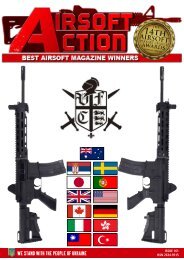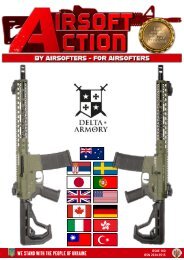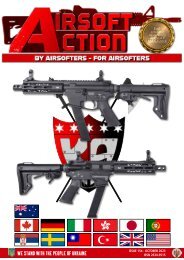PMCI - December 2019
As another year falls behind us once again PMCI brings the latest from the 2019 show scene with an overview of the colossal DSEI in London, an update on the SIG 938, news from ASP Batons and Torrent Suppressors, along with an in depth look at the latest creation from celebrity shooter, bladesmith, and all-round good guy Dustin Rhodes. As we look forward to SHOT 2020, there's something for everyone to get excited about in this latest issue!
As another year falls behind us once again PMCI brings the latest from the 2019 show scene with an overview of the colossal DSEI in London, an update on the SIG 938, news from ASP Batons and Torrent Suppressors, along with an in depth look at the latest creation from celebrity shooter, bladesmith, and all-round good guy Dustin Rhodes. As we look forward to SHOT 2020, there's something for everyone to get excited about in this latest issue!
Create successful ePaper yourself
Turn your PDF publications into a flip-book with our unique Google optimized e-Paper software.
Rhodes not only appeared on Forged in Fire but went on to
compete on the Discovery Channel’s show, Master at Arms.
While entertaining, both these programs only scratched the
surface of displaying Rhode’s talent and creativity. Earlier this
year, I had the distinct pleasure of getting to know Dustin and
collaborating on a custom knife project. What would emerge a
few months later would be nothing short of amazing!
FIRST IMPRESSIONS
Based on the nature of the blades intended use as a large tactical
/ survival knife, Dustin tweaked his custom recurve chopper
design to become a combat camp variant. Built from 1080 High
Carbon steel, this knife was hand forged by the man himself,
Dustin Rhodes in his Forge Works shop located in Shobonier,
Illinois. Sporting an overall length of 12 5/8”, the menacing 8”
blade with a max width of 2 1/8” and very comfortable black
paper Micarta grips. The blade was finished in antique blue and
accompanied by a utility Kydex sheath featuring a quick clip for
easily attaching to a belt or gear.
When the knife arrived, removed it from the shipping box and
wiped the excess oil off. The razor-sharp edge quietly sliced
through the cloth I was using to dry the blade. I noticed the
balance for such a large knife was quite impressive. As I practiced
my grip on the contoured scales, I enjoyed how the weight
seemed comfortably forward of the ricasso over its choil. With
slightly less weight than a hatchet, knife did however, feel like
a tool of heavy destruction. Having spent time working in areas
with thick density underbrush, I could see how this knife could
easily play many roles during jungle operations for military, LE
and contractors alike.
FIELD TESTING
A few days later, I met up with fellow Swanson Media Group
writer, Jerry Moody at our private training grounds affectionately
known as “The Swamp” to give the chopper a workout. The main
goal was not to see how the blade would do in a competition
setting, but rather, an everyday, utility role for camping, hunting
and small chores around the range. We work hard, we play even
harder, we expect a custom camp blade to do the same.
To start with, Jerry set up a 4” diameter Ash log for me to
chop into. To put the hardness of this wood into perspective for
you, this is what Louisville Slugger makes their baseball bats out
of due to the high density factor. The expectation of this stage
of test was more to see what the wood did to the blade edge
and not so much what the blade did to the wood. Just cutting a
section of the log with a handheld sawsall took a considerable
about of time. After about 15 intense minutes of Jerry and I taking
turns on the log, there was a rather impressive about of damage
done to the log. The shock coming through the blade from striking
the immensely dense would was that of what one would image
striking two rolling pins together. Upon inspection of the blade’s
edge, it was still razor sharp without any dinging or rolling.
As with most knife tests, we had to include a water bottle test
because you never know when someone in camp will only want
half a bottle, right? You guys ask for it, so we include it. To reduce
any possible injury, I used the conveniently located lanyard hole
in the knife handle to attach cordage in order to secure it to my
wrist. With the flick of a wrist, the test was over, and the water
bottle was cleanly halved. It went so quickly; I repeated the
process several times just to get the full experience of what I
often see in slow motion videos.
BLADES: DUSTIN RHODES: CHOPPER
pmcimagazine.com


















